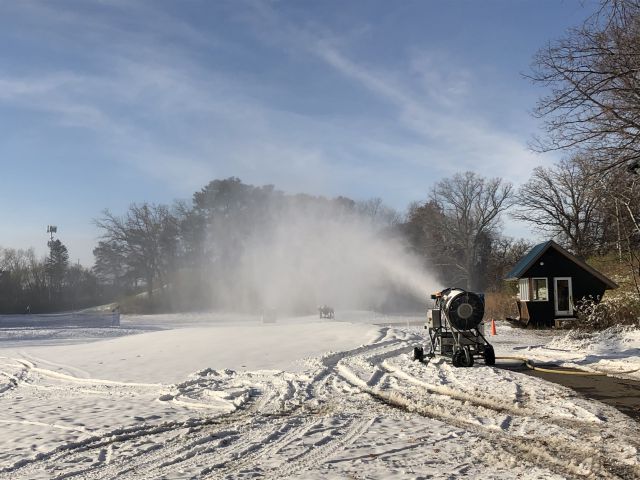October Snow Musings
The Benefit of Artificial Snow on the Ski Season
Wow -- a late October start on manmade snow at Wirth. Way to go!

Ever wondered how many extra days artificial snow adds to the ski season?
I looked at my skiing records and compared when I started skiing to when the natural snow ski season began and ended for the last 17 years. I usually start the same day or the day after Elm Creek opens. Elm Creek because I live in Maple Grove. My ski season ends when the snow starts to deteriorate and skiing is slow and no longer fun.
During the last 17 years the natural snow ski season (two inches or more on the ground) has varied from 21 days in 2011-12 to 113 days in 2013-14. The ski season with artificial snow has ranged from 80 days in 2014 to 148 days in 2017-18 (remember April skiing at Wirth?). The normal natural snow ski season is about 70 days or 10 weeks.
Artificial snow has made the average ski season about 113 days long or more than 50 percent longer than the natural snow ski season. The extra ski days on artificial snow is about evenly spread in front of the ski season (about 20 days) and at the end.
The average ski start day for natural snow for this period was about December 17. The average ski start date on artificial snow was about November 27 for the period. There are some irregularities with the ski start date for natural snow. In the 17 year period there were four years when skiing started for a few days and then the snow melted for some time. There were one or two melt intervals in those four years.
I do hope we still see enough natural snow so that we can venture out to other trails for variety.
A snowy October (we’re #1 this year) usually leads to a good snow year.
Snowy October
We’ve had 9.3 inches of snow this October which surpassed the previous record of 8.2 in 1991. The 1991 Halloween Blizzard started on Halloween and ended on November 1 with over 20 inches of snow. At that time the groomers were not ready to groom so we were on our own. Even that snow melted after a couple of weeks and we had a trace to no snow on the ground for about 3 days. That ski season was still long though extending for 125 days on natural snow as we didn’t have any snow-making then for XC.
So, are snowy Octobers somewhat indicative of the coming winter snows? The answer is that most of the top 20 snowy Octobers are followed by good natural snow ski seasons. Only 6 (30%) of the top 20 seasons had less than the average ski season of 70 days. The ski days ranged from a low of 23 in 1913-14 (anyone remember that one?) to a high of 130 in 1981-82 (I remember that one – heavy snows in January). Eight of the top 20 snowy Octobers had following ski seasons of over 100 days (40%).
The average natural snow ski season for the top 20 snowy Octobers was 83. The top ten snowy October ski seasons averaged 88 days. There were 3 clunkers in there at the top of the list with the now number three snowy October of 1905-06 with 46 ski days, number five 1959-60 also at 46 and number six 1925-26 with 33 ski days.
Cold Octobers (this year will end up as about the 7th coldest) had average ski years following with about 69 days for the top 10 coldest (note – there were 3 winters – 1873-74, 1875-76 and 1876-77 that were in the 10 coldest Octobers but there aren’t snowfall records for those seasons).
The top 10 wettest Octobers (precipitation – not all snow) were followed by ski seasons ranging from 18 to 116 ski days. They averaged 82 ski days. This October is at 2.41 inches of precipitation which is about 0.1 inch above normal.
It is looking promising. There will be a lot of traffic out there this year with the interest in getting outside during the pandemic.

